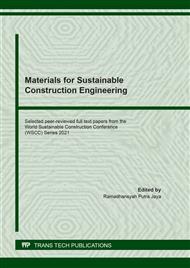[1]
M. S. Imbabi, C. Carrigan, and S. McKenna, Trends and developments in green cement and concrete technology,, Int. J. Sustain. Built Environ., vol. 1, no. 2, p.194–216, 2012,.
DOI: 10.1016/j.ijsbe.2013.05.001
Google Scholar
[2]
Global Cement Market (Production, Consumption, Imports & Exports): Insight, Trends and Forecast (2019–2021),, Koncept Analytics, 2019, 2021.
Google Scholar
[3]
Mineral Commodity Summaries 2020,, U.S. Geol. Surv., (2020).
Google Scholar
[4]
A. M. Rashad and S. R. Zeedan, The effect of activator concentration on the residual strength of alkali-activated fly ash pastes subjected to thermal load,, Constr. Build. Mater., vol. 25, no. 7, p.3098–3107, 2011,.
DOI: 10.1016/j.conbuildmat.2010.12.044
Google Scholar
[5]
A. M. Rashad, An exploratory study on high-volume fly ash concrete incorporating silica fume subjected to thermal loads,, J. Clean. Prod., vol. 87, no. 1, p.735–744, 2015,.
DOI: 10.1016/j.jclepro.2014.09.018
Google Scholar
[6]
A. Hasanbeigi, L. Price, H. Lu, and W. Lan, Analysis of energy-efficiency opportunities for the cement industry in Shandong Province, China: A case study of 16 cement plants,, Energy, vol. 35, no. 8, p.3461–3473, 2010,.
DOI: 10.1016/j.energy.2010.04.046
Google Scholar
[7]
Q. Wang, J. W. Yang, and P. Y. Yan, Influence of initial alkalinity on the hydration of steel slag,, Sci. China Technol. Sci., vol. 55, no. 12, p.3378–3387, 2012,.
DOI: 10.1007/s11431-012-4830-9
Google Scholar
[8]
Z. Pan et al., Investigating the effects of steel slag powder on the properties of self-compacting concrete with recycled aggregates,, Constr. Build. Mater., vol. 200, p.570–577, 2019,.
DOI: 10.1016/j.conbuildmat.2018.12.150
Google Scholar
[9]
Y. Jiang, T. C. Ling, C. Shi, and S. Y. Pan, Characteristics of steel slags and their use in cement and concrete—A review,, Resour. Conserv. Recycl., vol. 136, no. April, p.187–197, 2018,.
DOI: 10.1016/j.resconrec.2018.04.023
Google Scholar
[10]
J. Zang, W. Li, and X. Shen, The influence of steel slag with variable particle size distribution on the workability and mechanical properties of concrete,, Ceram. - Silikaty, vol. 63, no. 1, 2019,.
DOI: 10.13168/cs.2018.0046
Google Scholar
[11]
Y. Liu, Z. Zhang, G. Hou, and P. Yan, Preparation of sustainable and green cement-based composite binders with high-volume steel slag powder and ultrafine blast furnace slag powder,, J. Clean. Prod., vol. 289, p.125133, 2021,.
DOI: 10.1016/j.jclepro.2020.125133
Google Scholar
[12]
S. Z. Carvalho, F. Vernilli, B. Almeida, M. Demarco, and S. N. Silva, The recycling effect of BOF slag in the portland cement properties,, Resour. Conserv. Recycl., vol. 127, no. June, p.216–220, 2017,.
DOI: 10.1016/j.resconrec.2017.08.021
Google Scholar
[13]
M. A. Anifowose et al., Influence of Water Cement Ratios on the Optimum use of Steel Slag in Concrete,, J. Phys. Conf. Ser., vol. 1874, no. 1, p.012003, 2021,.
DOI: 10.1088/1742-6596/1874/1/012003
Google Scholar
[14]
O. Lotfi-Omran, A. Sadrmomtazi, and I. M. Nikbin, A comprehensive study on the effect of water to cement ratio on the mechanical and radiation shielding properties of heavyweight concrete,, Constr. Build. Mater., vol. 229, p.116905, 2019,.
DOI: 10.1016/j.conbuildmat.2019.116905
Google Scholar
[15]
G. A. Rao, Generalization of Abrams' law for cement mortars,, Cem. Concr. Res., vol. 31, no. 3, p.495–502, 2001,.
DOI: 10.1016/s0008-8846(00)00473-7
Google Scholar
[16]
A. P. B. Capraro, M. A. Cheremeta, M. P. G. Gonçalves, C. Cremonez, and M. H. F. de Medeiros, Influence of the cement type and water/cement ratio in concretes exposed in sewage treatment plants,, Constr. Build. Mater., vol. 229, 2019,.
DOI: 10.1016/j.conbuildmat.2019.116842
Google Scholar
[17]
S. B. Singh, P. Munjal, and N. Thammishetti, Role of water/cement ratio on strength development of cement mortar,, J. Build. Eng., vol. 4, p.94–100, 2015,.
DOI: 10.1016/j.jobe.2015.09.003
Google Scholar
[18]
Cement. Composition, specifications and conformity criteria for common cements,, vol. MS EN 197, (2011).
Google Scholar
[19]
ASTM International, Standard Test Method for Flow of Hydraulic Cement Mortar,, vol. ASTM C1437, (2015).
Google Scholar
[20]
Methods of test for mortar for masonry. Determination of flexural and compressive strength of hardened mortar,, vol. BS EN 1015, (2019).
DOI: 10.3403/01905442
Google Scholar
[21]
Testing concrete. Method for determination of water absorption,, vol. BS 1881: P, (2011).
Google Scholar
[22]
G. Morin and L. Briens, The effect of lubricants on powder flowability for pharmaceutical application,, AAPS PharmSciTech, vol. 14, no. 3, p.1158–1168, 2013,.
DOI: 10.1208/s12249-013-0007-5
Google Scholar
[23]
H. Qasrawi, F. Shalabi, and I. Asi, Use of low CaO unprocessed steel slag in concrete as fine aggregate,, Constr. Build. Mater., vol. 23, no. 2, p.1118–1125, 2009,.
DOI: 10.1016/j.conbuildmat.2008.06.003
Google Scholar
[24]
S. Rehman, S. Iqbal, and A. Ali, Combined influence of glass powder and granular steel slag on fresh and mechanical properties of self-compacting concrete,, Constr. Build. Mater., vol. 178, p.153–160, 2018,.
DOI: 10.1016/j.conbuildmat.2018.05.148
Google Scholar
[25]
F. Han, Z. Zhang, D. Wang, and P. Yan, Hydration heat evolution and kinetics of blended cement containing steel slag at different temperatures,, Thermochim. Acta, vol. 605, p.43–51, 2015,.
DOI: 10.1016/j.tca.2015.02.018
Google Scholar
[26]
X. Zhu, H. Hou, X. Huang, M. Zhou, and W. Wang, Enhance hydration properties of steel slag using grinding aids by mechanochemical effect,, Constr. Build. Mater., vol. 29, p.476–481, 2012,.
DOI: 10.1016/j.conbuildmat.2011.10.064
Google Scholar
[27]
Q. Wang and P. Yan, Hydration properties of basic oxygen furnace steel slag,, Constr. Build. Mater., vol. 24, no. 7, 2010,.
Google Scholar
[28]
K. S. Yeon, K. K. Kim, J. Yeon, and H. J. Lee, Compressive and flexural strengths of EVA-modified mortars for 3D additive construction,, Materials (Basel)., vol. 12, no. 16, 2019,.
DOI: 10.3390/ma12162600
Google Scholar
[29]
V. Afroughsabet and T. Ozbakkaloglu, Mechanical and durability properties of high-strength concrete containing steel and polypropylene fibers,, Constr. Build. Mater., vol. 94, p.73–82, 2015,.
DOI: 10.1016/j.conbuildmat.2015.06.051
Google Scholar
[30]
S. Aydin and B. Baradan, Effect of activator type and content on properties of alkali-activated slag mortars,, Compos. Part B Eng., vol. 57, 2014,.
DOI: 10.1016/j.compositesb.2013.10.001
Google Scholar
[31]
Y. C. Peng and C. L. Hwang, Carbon steel slag as cementitious material for self-consolidating concrete,, J. Zhejiang Univ. Sci. A, vol. 11, no. 7, p.488–494, 2010,.
DOI: 10.1631/jzus.a0900635
Google Scholar
[32]
J. Liu and R. Guo, Applications of Steel Slag Powder and Steel Slag Aggregate in Ultra-High Performance Concrete,, Adv. Civ. Eng., vol. 2018, 2018,.
DOI: 10.1155/2018/1426037
Google Scholar


